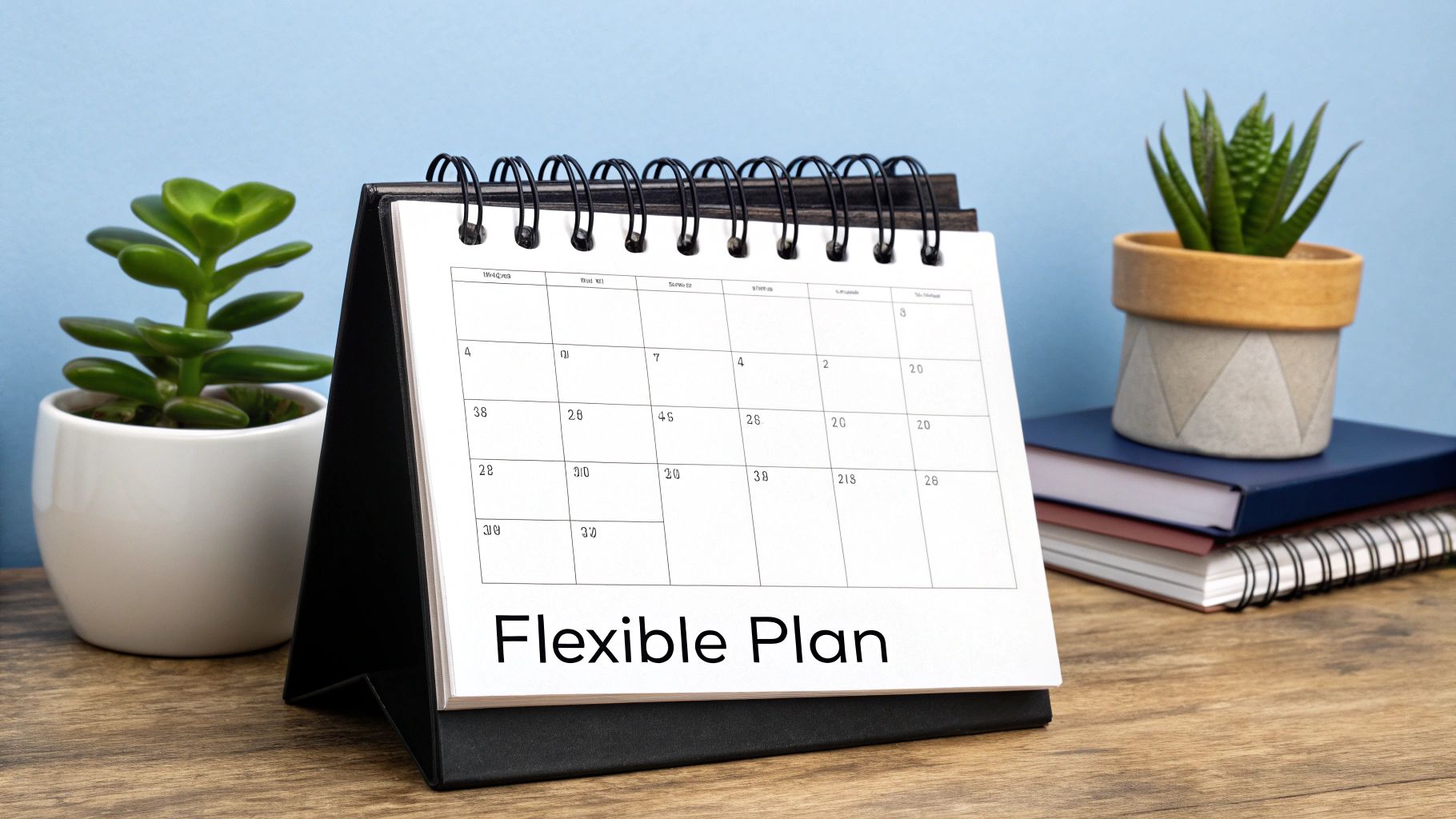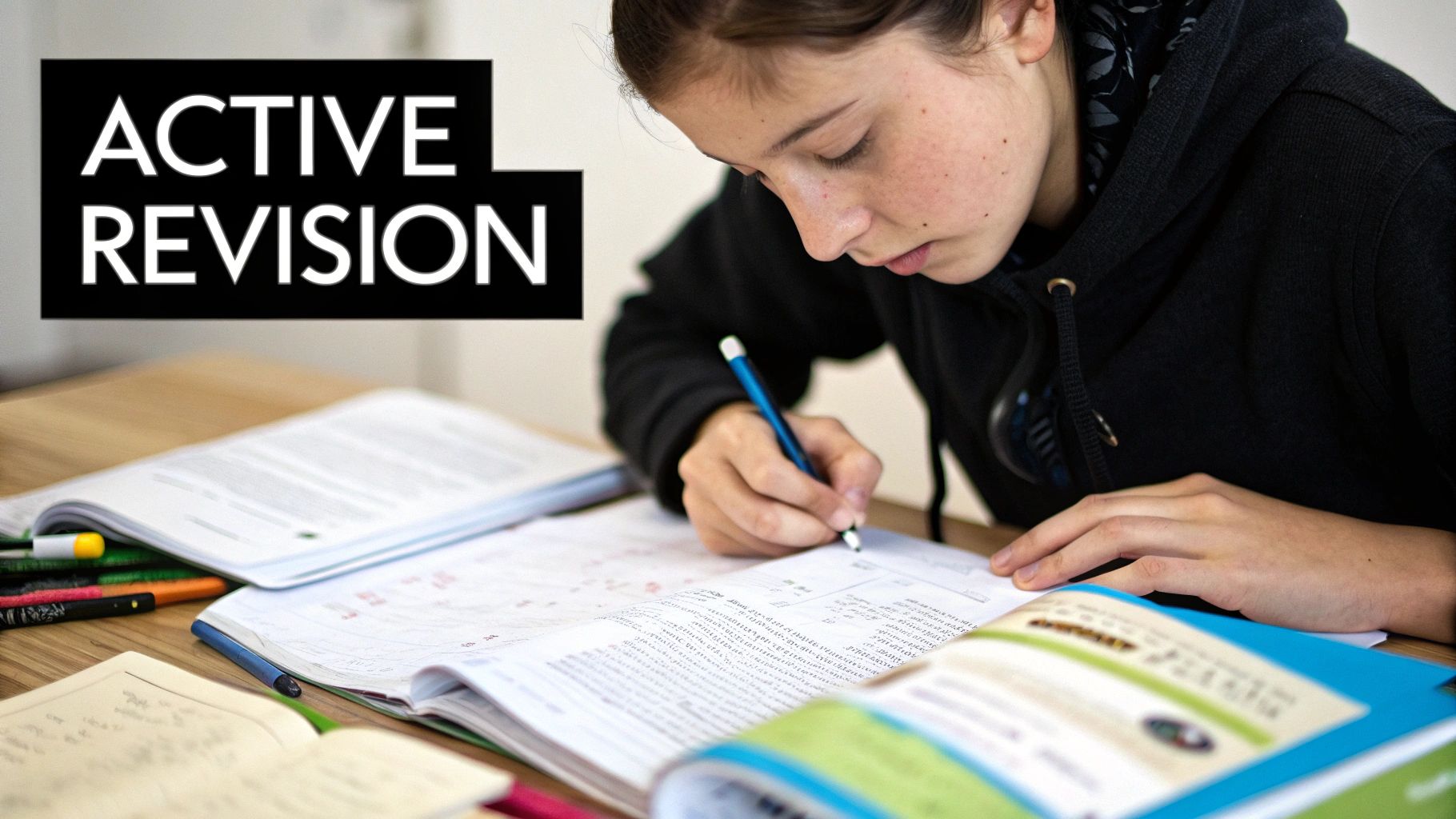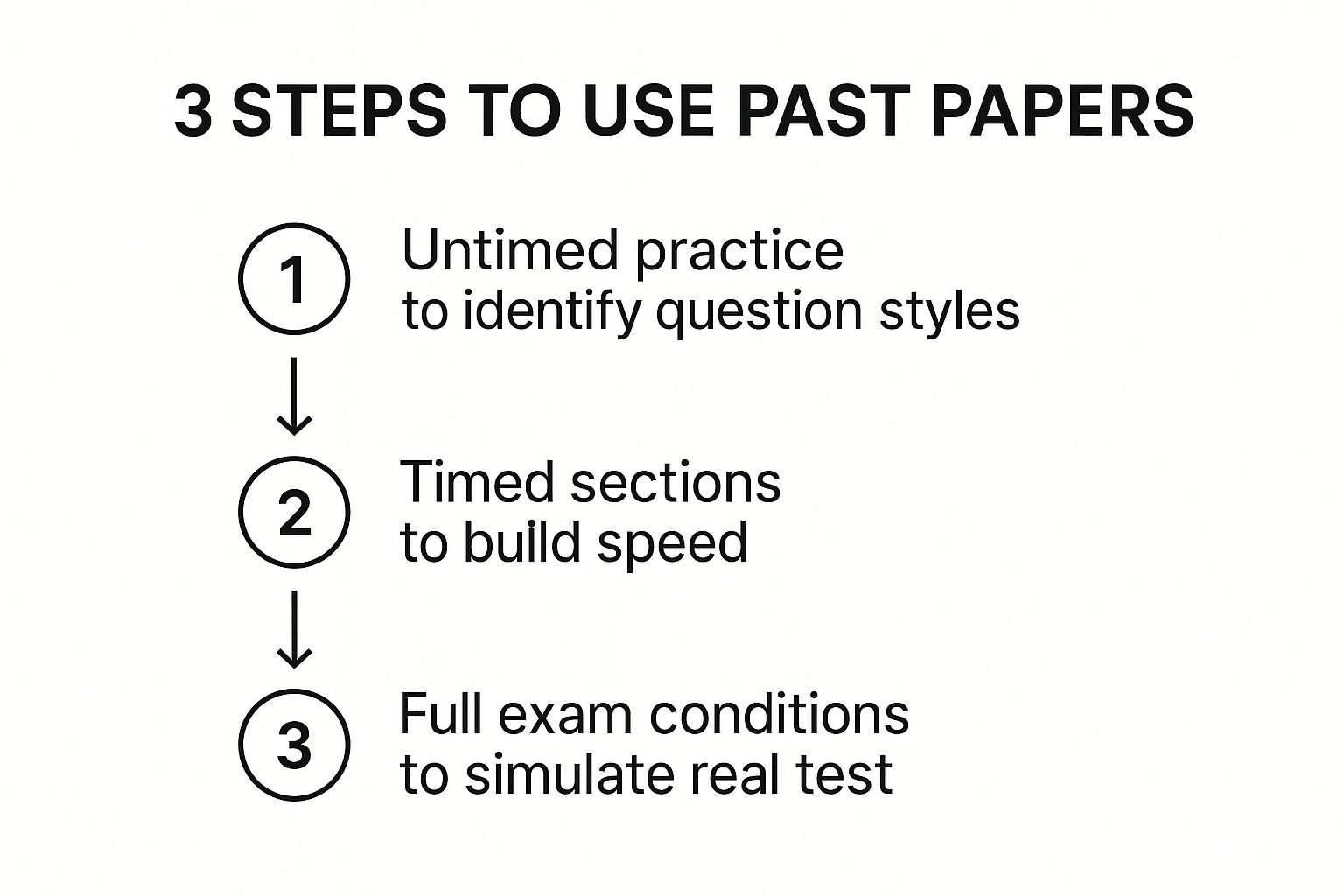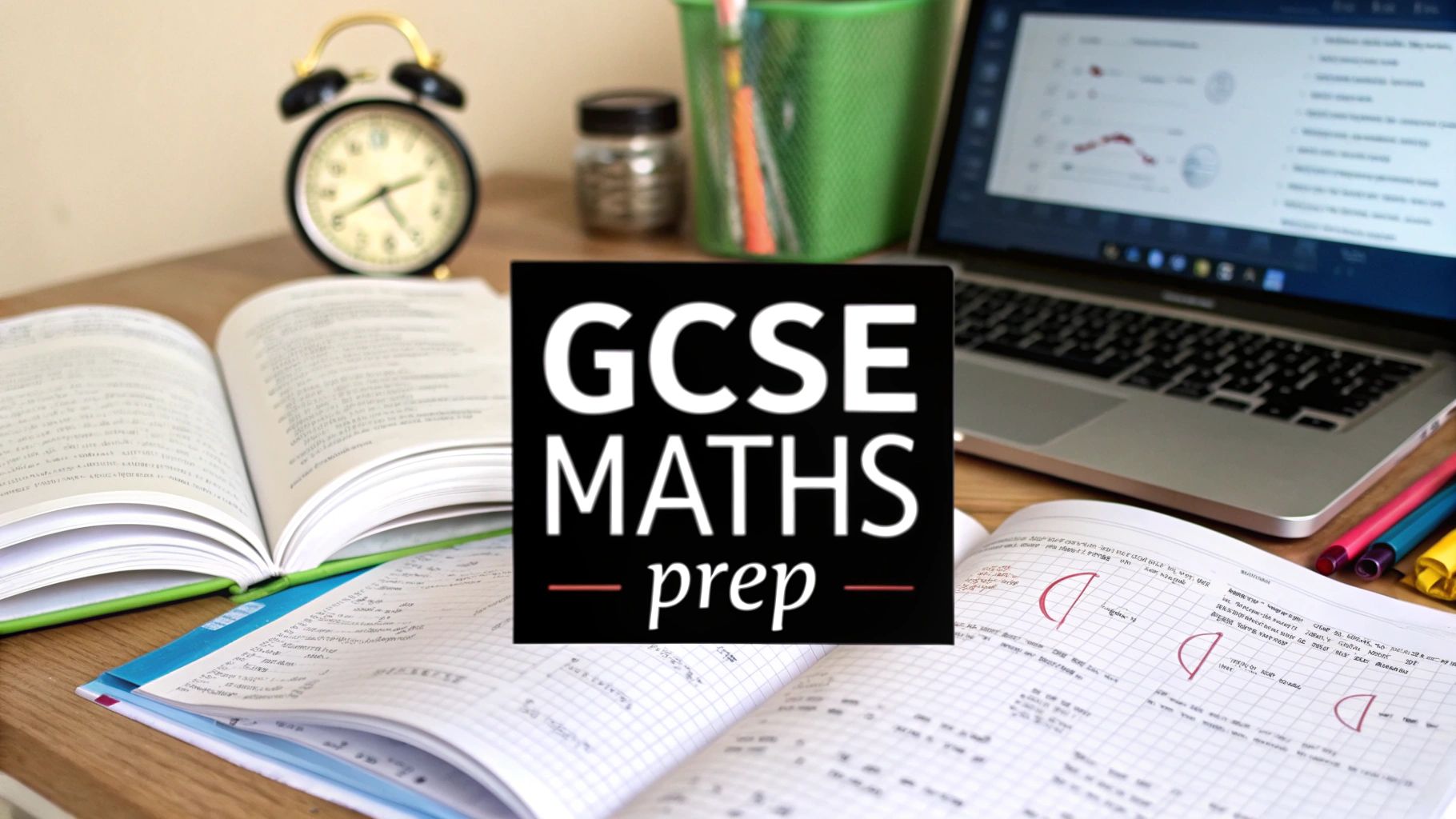The thought of revising for Maths GCSE can feel overwhelming, but what if you could turn that anxiety into confidence? It all boils down to a simple, powerful strategy: find out which topics make your child feel a little wobbly, create a gentle, consistent plan that mixes practice with understanding, and use past papers to make the real exam feel familiar and less scary. This approach turns what feels like a mountain into a series of manageable steps, building your child's belief in themselves from day one.
Your Stress-Free Start to GCSE Maths Revision
That feeling of staring at a mountain of Maths topics can be paralysing for any student. Where do they even begin? Forget generic advice; this is your calm, clear starting point, designed to focus on what truly matters—your child's individual needs and feelings.
Instead of getting bogged down by everything they need to know, the first step is to create a personalised map of their revision journey. It all starts with gently encouraging them to be honest about which topics feel comfortable and which ones seem daunting. We’ve all felt that knot in our stomach when faced with something like trigonometry or simultaneous equations! This simple act of acknowledgement turns that huge mountain into a series of small, conquerable hills, boosting their motivation and reducing anxiety right from the start.
Find Your Starting Point
The most common mistake students make is diving into revision without a plan. They can waste precious hours going over concepts they already understand well, while neglecting the areas where they're losing the most marks. This can be so frustrating and demoralising. Let's change that right now.
A quick self-assessment helps your child see exactly where they stand and what to prioritise. This isn't about testing them; it's about checking in with their gut feeling on each topic. Think of it as a traffic light system for their brain—a gentle, no-pressure way to see what needs care and attention.
"By taking the time to understand what went right and what went wrong, you can focus your attention on those areas that need the most improvement. This way, you can make the biggest difference to your grades in the shortest amount of time."
This initial self-reflection is the foundation for smart, efficient revision. It ensures every minute your child spends studying is targeted and effective, making them feel in control.
To get started, let's create a quick, honest snapshot of where they are right now. The table below is a simple tool to help them categorise every topic based on how they feel about it.
Your Personal Maths Revision Snapshot
| Maths Topic (e.g., Algebra, Geometry, Statistics) | Confidence Level (Red – Need Lots of Work) | Confidence Level (Amber – A Bit Unsure) | Confidence Level (Green – Feeling Confident) |
|---|---|---|---|
| Example: Simultaneous Equations | ✓ | ||
| Example: Pythagoras' Theorem | ✓ | ||
| Example: Histograms | ✓ |
Just get your child to grab their syllabus or a contents page and start sorting. Their "Red" list immediately becomes the priority—these are the topics where they can make the biggest gains and turn anxiety into achievement.
Why Consistent Effort Matters
It's tempting for students to think they can cram for Maths, but it’s probably the least effective method out there. It leads to panic and exhaustion. Mathematical concepts build on each other, and consistent, gentle practice is what really cements them in your child’s long-term memory. It’s about building muscle memory for their brain, not overwhelming it.
In fact, historical data from Ofqual shows that students who engage in systematic revision over at least 100 hours tend to improve their grade outcomes by 1 to 2 grade boundaries on average. This usually means regular study sessions over the three months leading up to exams. You can discover more insights from Ofqual's findings on their blog.
This isn't meant to cause alarm—it's to show that small, steady efforts add up to significant results. An hour a few times a week is far more powerful and less stressful than a frantic eight-hour session the weekend before the exam.
Now that you've helped your child map out their confidence with the self-assessment table, you have the clarity needed to build a revision plan that feels entirely their own.
Building a Revision Plan That Actually Works

Let's be honest, most revision timetables are abandoned within a week. They often start with good intentions but fail because they’re too rigid and don’t account for a child's need for downtime and flexibility. This section is all about creating a kind, adaptable plan that fits around your child’s life, not the other way around.
The real key to a successful plan is ditching the idea of long, draining study marathons. Instead, we'll embrace the power of 'little and often'. This approach makes revision feel less like a chore and more like a manageable part of their routine, helping them avoid the burnout that so many students face.
The Power of Short Bursts
Trying to focus on complex maths for hours on end is a recipe for frustration and tears. A child's brain simply isn’t designed to work that way. A far more effective and compassionate method is to break revision into short, focused sprints.
This is where techniques like the Pomodoro Technique come into play. It’s incredibly simple but remarkably effective for a young mind:
- Pick a single topic from their priority list.
- Set a timer for 25 minutes and encourage them to work on it with zero distractions.
- When the timer goes off, they take a 5-minute break. They should get up, stretch, grab a drink—anything but think about maths.
- After four ‘Pomodoros’, they take a longer break of around 15-30 minutes.
This method works because it respects the brain's natural attention span. Those short, frequent breaks are essential for helping your child's mind reset and absorb information, turning revision from a daunting task into a series of achievable sprints. It helps build momentum and keeps them feeling in control and positive.
Balancing Your Topics for a Smarter Schedule
A classic mistake is creating a schedule that lumps all the difficult topics together. This is a fast track to draining a child's motivation and making them feel like a failure. A smarter, kinder approach is to balance revision sessions by mixing topics from their 'Red' (difficult) and 'Amber' (a bit unsure) lists with those from their 'Green' (confident) list.
Here’s a practical example of how you could help them structure a revision week:
- Monday: Start with a 25-minute session on a tricky 'Red' topic like Trigonometry. Follow it with a session on a 'Green' topic like Percentages to end on a high and boost their confidence.
- Wednesday: Tackle an 'Amber' topic such as Histograms, then review a 'Green' one like Pythagoras' Theorem to reinforce that feeling of competence.
- Friday: Dedicate two sessions to a challenging 'Red' topic, but sandwich a quick review of an easier topic in between to break it up and prevent frustration.
This strategy keeps their energy levels up and prevents them from feeling stuck or overwhelmed. Every session feels productive because they're either conquering a challenge or reinforcing what they already know, which is a huge confidence booster. For a deeper dive into organising their time, our guide on time management for students offers more excellent strategies.
Making Information Stick with Spaced Repetition
Has your child ever revised a topic, felt they completely understood it, then felt that sinking feeling of forgetting it all a week later? It’s completely normal, and it's where a clever technique called spaced repetition becomes their best friend.
The idea is simple: instead of cramming a topic once and hoping for the best, they revisit it at increasing intervals. This process signals to their brain that the information is important, helping to move it from short-term to long-term memory—exactly where they need it on exam day.
A revision plan shouldn't just be a list of topics to cover. It should be a dynamic tool that schedules when to revisit them. This is the difference between simply seeing information and truly helping your child to learn it.
Here’s how to put it into practice:
- Day 1: Learn a new concept (e.g., solving quadratic equations).
- Day 2: Briefly review the concept for 10-15 minutes.
- Day 7 (A week later): Revisit the topic with some practice questions.
- Day 21 (Three weeks later): Do another quick review.
By spacing out revision like this, you interrupt the 'forgetting curve'. Each review strengthens the memory, making recall faster and more reliable under exam pressure. This is how you help your child build a solid foundation of knowledge that won't disappear when they walk into the exam hall.
Mastering Topics the Smart Way

Simply rereading a textbook is one of the biggest revision traps out there. It feels productive, but their brain isn’t actually doing the heavy lifting that GCSE Maths requires. To really help a topic sink in for your child, they need to switch from passive reading to active learning.
Active revision is what makes the information stick. It forces their brain to engage, building stronger neural pathways and a much deeper understanding. It’s the difference between vaguely recognising a formula and knowing precisely how and when to apply it when their heart is pounding in the exam.
Let’s walk through a powerful three-part cycle that works for every single topic on their revision list: Understand, Practice, and Check. This simple loop ensures they go beyond the surface and properly embed the knowledge for exam day.
Stage 1: Understand the ‘Why’
Before your child jumps into a single practice question, encourage them to stop and ask: "Do I actually get what this is for?" Just memorising formulas without understanding their purpose is a recipe for disaster. As soon as an exam question is worded a bit differently, that memorised rule can suddenly feel completely useless, leading to panic.
Understanding is all about grasping the core concept, the story behind the numbers. Let’s take a topic that often feels a bit abstract at first.
Practical Example: Compound Interest
- Don't just memorise:
Final Amount = Principal x (1 + Rate/100)^n - Understand the 'why': Talk about it like a real savings account. "Imagine you put £100 in the bank. Compound interest just means next year you earn interest on your original £100 and on the little bit of interest you've already earned. It's 'interest on interest'—which is why the total grows faster and faster over time." Relating it to their world makes it real.
This conceptual anchor is crucial. When your child is trying to get their head around tough maths topics, their ability to concentrate is everything. Exploring practical ways to increase focus and concentration can make a massive difference to how effective these study sessions are.
Stage 2: Practise with Purpose
Once the concept clicks, it’s time to put it into action. But not all practice is created equal. The goal is to build up their skills gradually, like levelling up in a video game. If they dive straight into the hardest questions, it will just knock their confidence.
Instead, help them structure practice sessions like this:
- The Warm-Up: Kick off with simple, direct questions. These are just to check they know how to apply the basic formula or method without any tricks. This builds a feeling of success.
- The Challenge: Next, move on to slightly more complex problems. These might involve a few extra steps or even require pulling in knowledge from another topic. This helps them feel stretched, but not overwhelmed.
- The Exam-Style Question: Finally, tackle a genuine past paper question. These are often wordy and force them to figure out which method to use before they can even start calculating. It's about problem-solving, not just sums.
Stage 3: Check and Learn From Mistakes
This final step is easily the most important, yet it's the one most students skip out of fear. Getting a question wrong isn't a failure; it's a huge learning opportunity. The real progress happens when your child feels safe to figure out why it went wrong.
"Every mistake is a signpost. Don't just look at it and walk away. Read what it says. It's pointing you directly to a gap in your knowledge that you now have the power to fix."
When they mark their work, encourage them not to just stick a red cross next to the wrong answer. Help them play detective and investigate the error properly.
- Was it a silly slip? Maybe they added instead of subtracting. These are usually signs of rushing, which often comes from anxiety.
- Was it a calculation error? A simple mistake with the calculator can happen to anyone. It's okay.
- Was it a conceptual misunderstanding? This is the goldmine. Did they use the wrong formula or just misunderstand what the question was asking for? This is where the real learning happens.
Suggest they keep a 'mistake log' in a notebook. For every error, they can jot down the question, a quick note on why they got it wrong, and the correct way to solve it. Glancing over this log before each session is one of the fastest ways to patch up those knowledge gaps and make sure they never make the same mistake twice.
Using Online Tools to Your Advantage
Let's be honest, staring at a textbook and a pen for hours isn't always the most inspiring way for a child to revise. The good news is, they don't have to. The internet is packed with incredible resources built for GCSE Maths, capable of turning a lonely chore into something interactive and even fun.
Stepping away from purely traditional methods can be the very thing that helps a tricky topic finally click into place for your child. These digital tools aren't just fancy extras; they're powerful assets. When used properly, they help zero in on weaknesses, get expert help exactly when it's needed, and make study sessions feel more like a challenge to be conquered than a task to be endured.
Your Go-To Digital Revision Kit
Is your child feeling completely stuck on algebra? Overwhelmed by probability? There’s a free online tool designed for that exact problem. Platforms created by teachers have become game-changers for students, offering the kind of clear, targeted support that makes a genuine difference.
If you only bookmark two sites for them, make them Corbett Maths and MathsBot.
- Corbett Maths: Famous for its ‘5-a-day’ questions, this site is brilliant for daily practice that keeps everything ticking over without being overwhelming. Its real secret weapon is the library of short, sharp videos explaining every topic on the syllabus. Each one is followed by practice questions and, crucially, the answers, providing instant reassurance.
- MathsBot: Think of this as a personal practice generator. Your child can create endless quizzes on any topic, from simplifying fractions to solving complex equations. It's perfect for drilling a skill until it becomes second nature and they feel that buzz of getting it right.
These platforms are popular for a reason—they get millions of visits from UK students every year. But more importantly, they work. Research shows that students who mix structured video tutorials with interactive quizzes can see a 15-25% improvement in their mock exam scores after just eight weeks. It's also worth checking out other ideas educators recommend; you can discover a range of fantastic revision activities that really shake things up.
Weaving Online Tools into Your Schedule
Just knowing these sites exist isn’t the solution. The trick is to build them into the revision timetable you’ve already created for your child. Treat them like on-demand tutors, ready to jump in whenever they hit a wall. This keeps their online time focused and stops them from falling down a rabbit hole of distraction.
Here’s a simple, practical way to do it:
- Hit a ‘Red’ Topic? Before your child wastes an hour getting frustrated, guide them straight to Corbett Maths. Watch the 10-minute video explaining the concept together. Sometimes, seeing it explained visually by someone else is all it takes for the penny to drop.
- Ready to Practise? After the video, they can jump over to MathsBot and generate a quick 10-question quiz on that specific topic to prove to themselves they've got it. That immediate success is a huge motivator.
- Daily Warm-Up: Encourage them to kick off every revision session with the Corbett Maths ‘5-a-day’. It’s a fantastic, low-pressure way to keep different topics fresh in their mind and it barely takes 15 minutes.
Your child's textbook provides the foundation, but online tools give them the endless practice and instant feedback they need to build real confidence. They put your child in control, letting them fill the specific gaps in their knowledge the moment they appear.
This blend of old-school and new-school makes revision so much more dynamic. Your child isn't just passively reading—they’re watching, doing, and immediately checking their work. And if you're curious about the wider world of digital education, our guide to the best online learning platforms offers some great insights into what makes an online tool truly effective.
Making Past Papers Your Secret Weapon
If there's one thing that will give your child a serious edge, it's past papers. They are the single most powerful tool in their revision arsenal. Think of them as the final dress rehearsal before the big show—they're the closest your child will get to the real exam, demystifying the whole experience by showing them exactly what to expect.
But using them correctly is an art. It’s about more than just random testing; it’s about turning them into a strategic learning tool that builds unshakeable confidence. The goal isn't to start with a frantic, timed test that leaves your child feeling panicked. That approach often does more harm than good. Instead, we'll walk through a gradual process designed to build their skills and self-belief, step by step.
From Practice Run to Exam Simulation
The key is to approach past papers in three distinct stages, each with a specific, gentle goal. This structured method helps your child get comfortable with the format, build up their speed, and finally, prepare their mind for the pressure of exam day. Each stage builds on the last, ensuring they feel ready for anything.
This infographic breaks down the simple, three-step process for making past papers a core part of your child's revision.

As you can see, it’s a clear progression. You start by just helping them understand the challenge before moving on to building the speed and resilience they'll need on the day.
Let’s explore what each of these stages looks like in practice.
-
Untimed Exploration: Their first few encounters with a past paper should be done with no clock ticking. The only goal here is to get familiar with the language and structure. They can work through it at their own pace, with notes and a textbook right beside them for reassurance. This is their chance to see how topics are combined and get a feel for the multi-step problems without any pressure.
-
Timed Sections: Once they're comfortable, it’s time to bring in the clock, but in a manageable way. Instead of tackling a full 90-minute paper and feeling overwhelmed, break it into three 30-minute sections. This helps them build speed and get used to time pressure without it feeling impossible. It’s a great way to train their brain to work efficiently in short, focused bursts.
-
Full Exam Conditions: This is the final and most important stage. Help your child replicate the real exam environment as closely as possible. That means a quiet room, no phone, no notes, and a timer set for the full paper. This practice is crucial not just for their maths skills, but for their mental preparation. They'll learn to manage their time, handle their nerves, and build the stamina needed to stay focused. Preparing for a full-length test is also essential for success; our guide on how to prepare for your mock exam GCSE offers brilliant tips on simulating these conditions effectively.
The Real Magic Is in the Marking
Finishing a past paper is only half the battle. The real learning happens when your child marks it. This is where they turn mistakes into genuine progress. Just counting up their score and moving on is a massive wasted opportunity. They need to dig into every wrong answer to understand exactly where they went wrong, without judgement.
"Your mistake log is the most personal and powerful revision guide you will ever create. It’s a direct map to the marks you’re currently leaving behind, showing you exactly where to focus your energy."
Help your child create a dedicated 'mistake log'. For every question they get wrong, they can write down:
- The Topic: What area of maths was it? (e.g., trigonometry, solving equations).
- The Error Type: Why did they get it wrong? Was it a silly slip, a conceptual error, or did they just not understand the question? Being honest here is key.
- The Correction: Write out the full, correct solution, explaining each step to themselves as if they were teaching it to someone else. This act of "teaching" solidifies understanding.
This process is transformative. It forces them to confront their weaknesses head-on, systematically closing those knowledge gaps one by one. Reviewing their mistake log before each practice session is one of the most efficient ways to ensure they don't keep making the same errors.
The impact of this disciplined practice is huge. Simulating real exam conditions correlates strongly with increased confidence and higher marks. Research has even shown up to a 20% improvement in accuracy when students practise with timed past papers during revision. This confirms that the effort you put into realistic practice pays off directly in your final results.
Managing Exam Nerves and Staying Positive
All the revision your child has done for GCSE Maths is crucial, but on the big day, their mindset is just as important as their algebra skills. It’s completely normal for them to feel their stomach doing flips as the exam gets closer, but they don't have to let that anxiety take over. This section is all about looking after them—the person behind the past papers.
After weeks of intense focus, feeling tired or overwhelmed is a real risk. Just acknowledging that with your child is the first step. To keep their revision sustainable without them hitting a wall, it’s worth looking at tips on how to avoid burnout and keep their energy levels steady. Their wellbeing is the foundation of their success.
Simple Techniques to Calm Your Mind
When nerves kick in, the body goes into ‘fight or flight’ mode, making it incredibly difficult to think clearly. The simplest way to help your child get back in the driver's seat is to get them to focus on their breath. It sounds almost too easy to be true, but it genuinely works by calming the nervous system.
Here’s a practical exercise they can do absolutely anywhere, even sitting outside the exam hall:
- Box Breathing:
- Breathe in slowly through the nose for a count of four.
- Hold the breath for a count of four.
- Breathe out slowly through the mouth for a count of four.
- Hold the breath again for a count of four.
Repeating this cycle three or four times forces the mind to concentrate on the rhythm, pulling them away from spiralling thoughts and physically lowering their heart rate. This small action can make a huge difference, helping them walk in feeling centred and ready.
After all their hard work, this is their moment to shine. A calm mind can access all the information they’ve so carefully stored away. Remind them they’ve earned this opportunity.
Your Exam Eve Checklist
Feeling prepared is a powerful antidote to anxiety. The night before the exam isn’t for late-night cramming; it’s for calming down and getting organised so your child can wake up feeling as ready as possible.
Run through this simple checklist together to set them up for a stress-free morning:
- Pack Their Bag: Get their clear pencil case sorted. They’ll need black pens, pencils, a rubber, a sharpener, a protractor, a pair of compasses, and of course, their calculator.
- Check The Calculator: Pop in some fresh batteries. The last thing they need is for it to die halfway through a question!
- Lay Out Their Clothes: Decide what they're wearing to remove one more decision from their plate on exam morning.
- Fuel Their Brain: Have a balanced evening meal and plan a decent breakfast. Try to avoid the temptation to rely on sugary snacks or energy drinks for a boost.
- Set Their Alarm: Maybe even set two if they're worried! Knowing they have plenty of time helps them relax.
- Switch Off: Aim for them to stop revising at least an hour before bed. They could watch something funny, listen to music, or read a book—anything to give their brain a proper break. A good night's sleep is the best revision they can do at this point.
Common GCSE Maths Revision Questions
It’s completely normal for a child to have questions swirling around their head when they're deep in revision. Honestly, knowing other students are asking the same things can be a huge comfort. Let's tackle some of the most common queries to give your child that extra bit of clarity and confidence.
How Much Revision Should I Do?
This is the big one, but there’s no magic number. Consistency and kindness are far more important than cramming.
A great starting point is to aim for three to five focused sessions a week, each lasting around 30-60 minutes. It's a 'little and often' approach. This is so much more effective than one long, draining session on a Sunday because it gives their brain time to move information into long-term memory without causing burnout.
What If I Get Stuck on a Topic?
First off, tell them not to panic. And they definitely shouldn't struggle alone for hours—that’s just a recipe for knocking their confidence. The best strategy is to step away and look at the problem from a fresh angle.
Getting stuck isn't a sign of failure—it's a sign that you need to see the problem from a new angle. Use it as an opportunity to deepen your understanding.
A great first move is to find a video tutorial on a site like Corbett Maths to hear someone else explain it. If that doesn't quite click, they should make a specific note of the question and ask their teacher for help. That’s what they’re there for, and it shows they're taking control of their own learning.
At Queens Online School, we believe in providing personalised support to help every child overcome challenges and build confidence. Our expert teachers are dedicated to making complex topics click. Discover how our online GCSE courses can transform your child's learning journey.

